How to siphon soil in an aquarium?
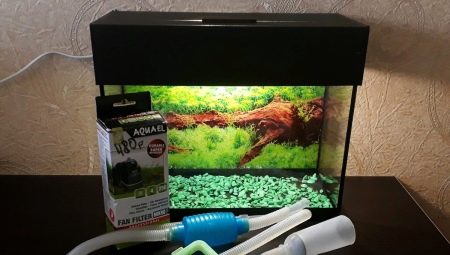
The aquarium is a closed ecosystem and needs to be maintained in optimal balance with the help of the owner. Fish must live clean. Correct and timely cleaning of the soil is the key to the long life of pets.

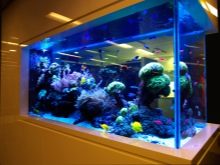

Why siphon soil?
Inhabitants of a domestic reservoir secrete waste products, all this settles to the bottom and mixes with the soil, which may consist of sand, small stones and other fillers. In the process of natural decomposition of food residues and excretions of pets, decay products appear, which negatively affect the purity of the water and the population of the reservoir.
In any aquarium, it is imperative to siphon the bottom from time to time, even if the water seems clear. Remains of feed, faeces, algae particles, falling to the bottom, create an ecological balance in the tank. But there may come a time when the waste content exceeds the norm. The water will become cloudy and become dangerous for the fish - the accumulated sediment can kill the inhabitants of the aquarium.
To prevent a negative scenario, an urgent need to siphon the soil. The regularity of the cleaning procedure depends on the volume of the home reservoir, the number of fish, plants and other organisms living in it. The work of removing contaminants from the pond is an essential element in maintaining a comfortable aquarium environment.
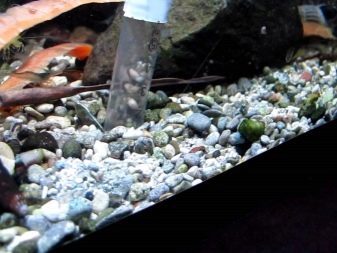

The simplest and most effective method to find out if an urgent need to tidy up the aquarium is to stir the soil. If air bubbles rise from the strata in large quantities or the liquid smells of hydrogen sulfide, it means that a negative process is taking place in the bottom sediments. It's time to start cleaning work.
Sometimes it happens that this method does not work, for example, if there is no living plant in the tank. In these circumstances, you will need to use other tests.
But there are also often times when cleaning the soil in the aquarium is not worth it.
- It is forbidden to clean the newly acquired reservoir for the first two weeks. First you need to give time for the formation of colonies of bacteria. Only partial water changes are allowed.
- Cleaning is rarely done in aquariums with small pets and densely populated algae. The slowing down of decomposition processes is due to the fact that a good root system, passing through the soil, facilitates the access of oxygen to all layers of the soil. The resulting air prevents the formation of oxygen-free areas.
- It is forbidden to siphon herbal aquariums densely populated with plants. This destroys the ecological balance, lifts silt from the bottom, stimulates the release of harmful substances and damages algae nutrient deposits.

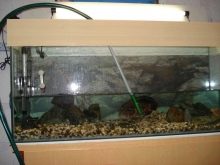
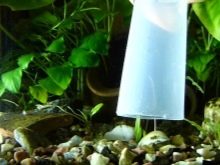
The benefits and harms of cleaning
Positive sides:
- regular partial water changes;
- removal of harmful waste contaminating the tank;
- elimination of soil caking for better oxygen access and the development of beneficial bacteria.
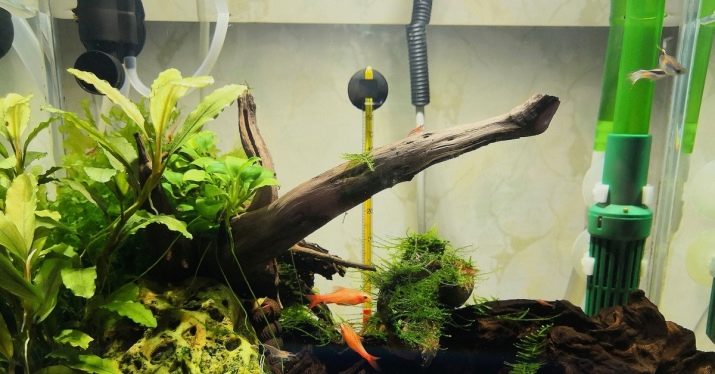
Negative sides of soil cleaning:
- the top layer of the soil is disturbed, which leads to the death of beneficial bacteria;
- the ability of biological treatment is deteriorating;
- the risk of damage to the roots of algae increases.
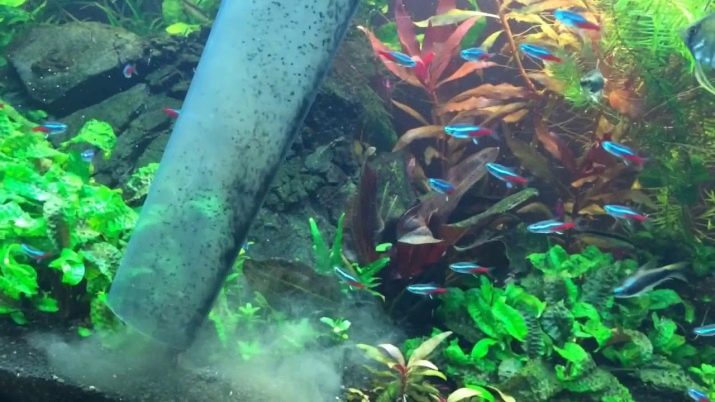
How to use a siphon?
The siphon is a special device for cleaning the soil in an aquarium, which works on the principle of a conventional pump, pumping out contaminated grains from the surface and the inner layer of bottom sediments from the tank.
An ordinary siphon consists of a transparent corrugated tube, various types of funnel and a pear. This is the simplest and most efficient pump.
There are also devices that are electrically powered from the mains or batteries, they do not drain the water from the aquarium, but clean it through special filters and return it back to the tank. As a rule, such pumps are used in reservoirs with intensive pollution of the bottom, but frequent water changes are contraindicated there.
To properly siphon the soil in the aquarium, you first need to prepare the inventory. This is the siphon itself, any water container and rags. With good preparation, the cleaning process will be easy and trouble-free.
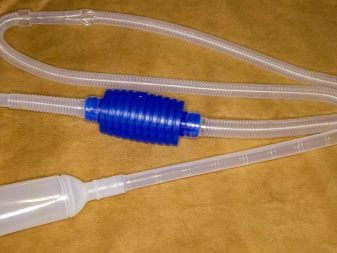

Usually, at home, this process is combined with a liquid change in the aquarium.
- The bucket for draining the liquid must be installed below the level of the tank to facilitate the outflow of water.
- Place a rag or towel on the edge of the aquarium to prevent liquid splashing when pumping out food debris and other waste. You can also use the towel to wipe your hands, which will be wet most of the time when using the siphon.
- We immerse the tip of the dirt cleaner in the aquarium and begin to siphon the bottom. We create pressure with a pear, and under the influence of contaminated particles, together with water, are sent to a prepared bucket or other container.
- Sandy soil should be cleaned by carefully passing with a funnel without touching the bottom. In tanks with plants, care should be taken not to damage the roots when cleaning the silica sand from dirt and silt deposits. If the fine fractions of the soil still got into the siphon during cleaning, then it is imperative to return them back to the tank, after rinsing it under running water.
- If the soil consists of pebbles, then first we clean the surface, after which we briefly immerse the pump funnel in the ground and raise it; this operation must be done several times, moving the siphon along different parts of the aquarium. You should not go deeper to the very bottom, only if the aquarium has not been cleaned for a long time.
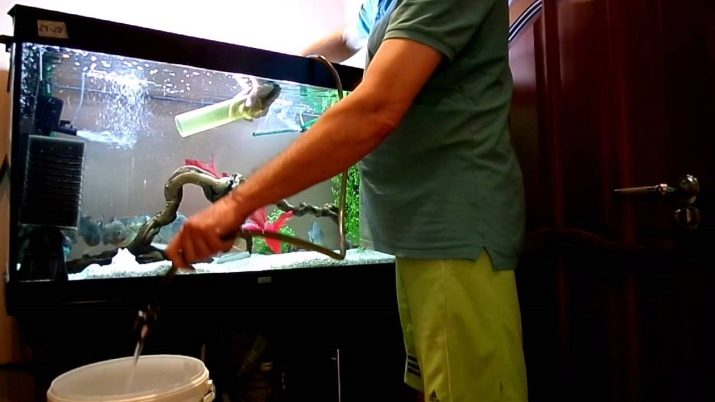
In a small reservoir, you have to siphon the soil more often, almost once a week, and if fry live there, then every day.In a tank with a volume of more than 200 liters with living plants living in it, the bottom is cleaned at least once a month. If there is no live algae in a large-capacity aquarium, then work is carried out approximately once every two weeks or as it gets dirty.
The cleaning procedure is similar to replacing the water in an aquarium. There is no need to relocate the inhabitants of the home reservoir anywhere.
After completing all the work, you need to add clean water and wait a while until the dregs settle.
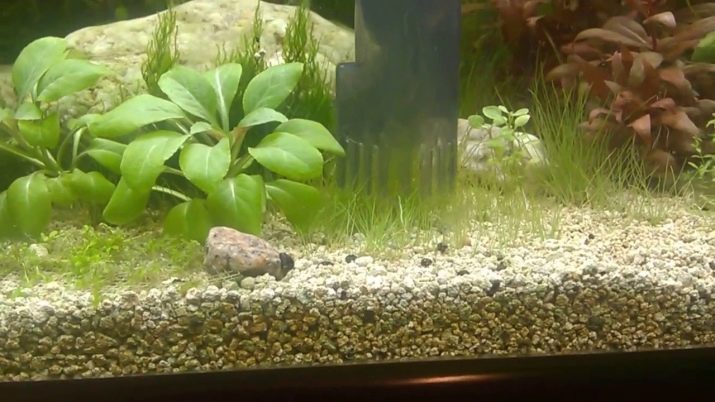
Care and maintenance
Siphons are simple and easy to maintain. After completion of work, the device should be disassembled and washed in running water. If the device is very dirty, a mild soap solution can be used. Then rinse thoroughly and wipe dry.
It must be remembered that any chemicals are harmful to fish. If it is not possible to wash, then the parts must be replaced with new ones.

What can I do to clean the bottom less often?
In order to less often carry out the procedure for cleaning the soil at the bottom of the aquarium, it will be necessary to reduce the number of fish in the reservoir, plant more algae with a reliable root system and exclude overfeeding of pets.
And even if all the rules are followed exactly and on time, the siphon will still remain a necessary accessory in the kit of aquarium lovers.
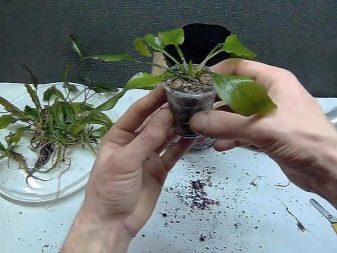
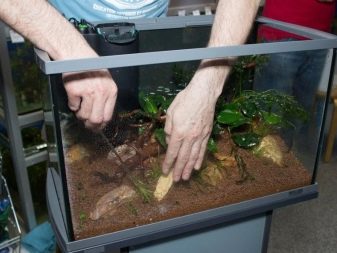
How to siphon soil in an aquarium, see the video below.








